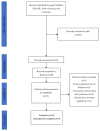Effect of Exercise on Inflammation in Hemodialysis Patients: A Systematic Review
- PMID: 35887685
- PMCID: PMC9322638
- DOI: 10.3390/jpm12071188
Effect of Exercise on Inflammation in Hemodialysis Patients: A Systematic Review
Abstract
Background: In recent years, physical exercise has been investigated for its potential as a therapeutic tool in patients with end-stage renal disease (ESRD) undergoing hemodialysis maintenance treatment (HD). It has been shown that regular practice of moderate-intensity exercise can improve certain aspects of immune function and exert anti-inflammatory effects, having been associated with low levels of pro-inflammatory cytokines and high levels of anti-inflammatory cytokines.
Purpose: The aim of this review is to examine the studies carried out in this population that analyzed the effect of intradialytic exercise on the inflammatory state and evaluate which exercise modality is most effective.
Methods: The search was carried out in the MEDLINE, CINAHL Web of Science and Cochrane Central Register of Controlled Trials databases from inception to June 2022. The PEDro scale was used to assess methodological quality, and the Cochrane Risk of Bias Tool and MINORS were used to evaluate the risk of bias. The quality of evidence was assessed with GRADE scale. The outcome measures were systemic inflammation biomarkers.
Results: Mixed results were found in terms of improving inflammation biomarkers, such as CRP, IL-6 or TNFα, after exercise. Aerobic exercise seems to improve systemic inflammation when performed at medium intensity while resistance training produced better outcomes when performed at high intensity. However, some studies reported no differences after exercise and these results should be taken with caution.
Conclusions: The low quality of the evidence suggests that aerobic and resistance exercise during HD treatment improves systemic inflammation biomarkers in patients with ESRD. In any case, interventions that increase physical activity in patients with ESRD are of vital importance as sedentary behaviors are associated with mortality. More studies are needed to affirm solid conclusions and to make intervention parameters, such as modality, dose, intensity or duration, sufficiently clear.
Keywords: chronic kidney disease; exercise; hemodialysis; inflammation.
Conflict of interest statement
The authors certify that they have no affiliations with or financial involvement in any organization or entity with a direct financial interest in the subject matter or materials dis-cussed in the article.
Similar articles
-
Intradialytic training in patients with end-stage renal disease: a systematic review and meta-analysis of randomized clinical trials assessing the effects of five different training interventions.J Nephrol. 2020 Apr;33(2):251-266. doi: 10.1007/s40620-019-00687-y. Epub 2019 Dec 21. J Nephrol. 2020. PMID: 31865607
-
Exercise for dysmenorrhoea.Cochrane Database Syst Rev. 2019 Sep 20;9(9):CD004142. doi: 10.1002/14651858.CD004142.pub4. Cochrane Database Syst Rev. 2019. PMID: 31538328 Free PMC article.
-
Effects of intradialytic aerobic exercise on hemodialysis patients: a systematic review and meta-analysis.J Nephrol. 2019 Aug;32(4):549-566. doi: 10.1007/s40620-018-00565-z. Epub 2019 Jan 18. J Nephrol. 2019. PMID: 30659520 Free PMC article.
-
Intradialytic exercise training modalities on physical functioning and health-related quality of life in patients undergoing maintenance hemodialysis: systematic review and meta-analysis.Clin Rehabil. 2018 Sep;32(9):1189-1202. doi: 10.1177/0269215518760380. Epub 2018 Feb 26. Clin Rehabil. 2018. PMID: 29480025
-
Psychosocial interventions for preventing and treating depression in dialysis patients.Cochrane Database Syst Rev. 2019 Dec 2;12(12):CD004542. doi: 10.1002/14651858.CD004542.pub3. Cochrane Database Syst Rev. 2019. PMID: 31789430 Free PMC article.
Cited by
-
Does Intradialytic Group Exercise Programme Influence Patient-Reported Outcomes, Laboratory Parameters, and Anthropometric Parameters in Maintenance Hemodialysis Patients? A Single-Group Repeated-Measures Trial.Patient Prefer Adherence. 2023 Feb 21;17:491-501. doi: 10.2147/PPA.S400005. eCollection 2023. Patient Prefer Adherence. 2023. PMID: 36852381 Free PMC article. Clinical Trial.
-
Comparison of the effect of aerobic and resistance training on fatigue, quality of life and biochemical factors in hemodialysis patients.Sci Rep. 2025 Mar 24;15(1):10052. doi: 10.1038/s41598-025-94257-x. Sci Rep. 2025. PMID: 40122960 Free PMC article. Clinical Trial.
-
The effect of aerobic exercise on oxidative stress in patients with chronic kidney disease: a systematic review and meta-analysis with trial sequential analysis.Ren Fail. 2023;45(2):2252093. doi: 10.1080/0886022X.2023.2252093. Epub 2023 Sep 27. Ren Fail. 2023. PMID: 37753870 Free PMC article.
-
Comparative efficacy of nine exercise methods on the prognosis in chronic kidney disease patients with hemodialysis: a systematic review and network meta-analysis.Eur J Med Res. 2023 Oct 5;28(1):401. doi: 10.1186/s40001-023-01270-9. Eur J Med Res. 2023. PMID: 37798739 Free PMC article.
-
The Comparison of High-Intensity Interval Training Versus Moderate-Intensity Continuous Training after Coronary Artery Bypass Graft: A Systematic Review of Recent Studies.J Cardiovasc Dev Dis. 2022 Sep 28;9(10):328. doi: 10.3390/jcdd9100328. J Cardiovasc Dev Dis. 2022. PMID: 36286280 Free PMC article. Review.
References
-
- Eleftheriadis T., Antoniadi G., Liakopoulos V., Kartsios C., Stefanidis I. Seminars in Dialysis. Volume 20. Blackwell Publishing Ltd.; Oxford, UK: 2007. Basic science and dialysis: Disturbances of acquired immunity in hemodialysis patients; pp. 440–451. - PubMed
-
- Segura-Ortí E. Ejercicio en pacientes en hemodiálisis: Revisión sistemática de la literatura. Nefrología. 2010;30:236–246. - PubMed
Publication types
LinkOut - more resources
Full Text Sources
Research Materials
Miscellaneous


